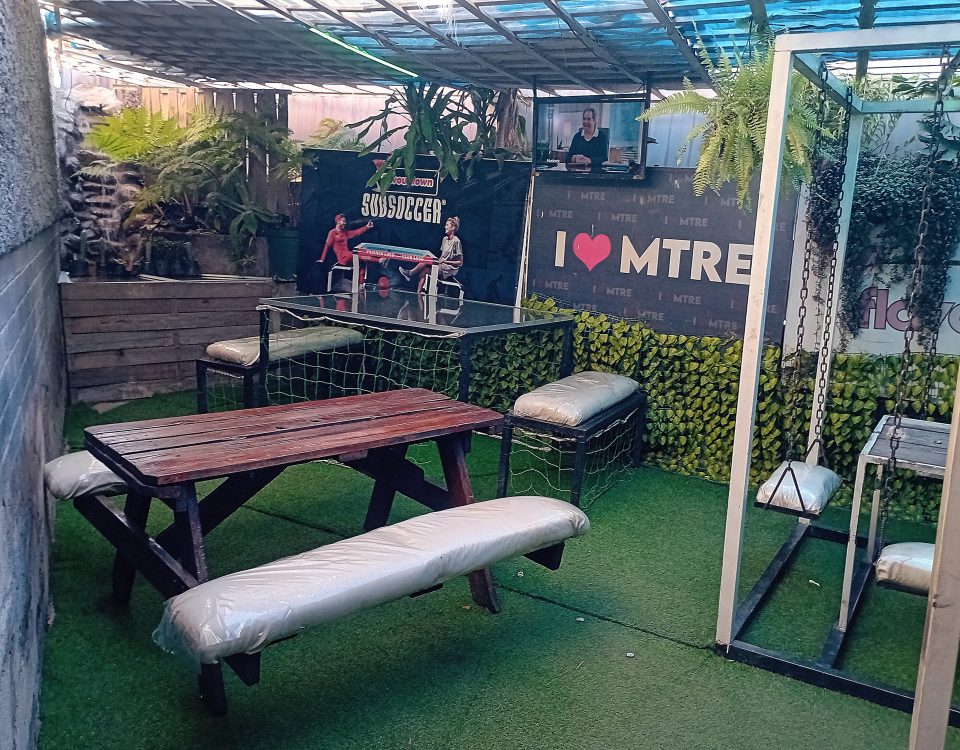
Law enforcement, ‘behaviour change’ drawback Zim’s anti-litter pollution strides
March 21, 2019
Correctional service in Zimbabwe’s prisons, myth or truth?
April 3, 2019Zimbabwean Rastafarian’s untold life of environmental livity
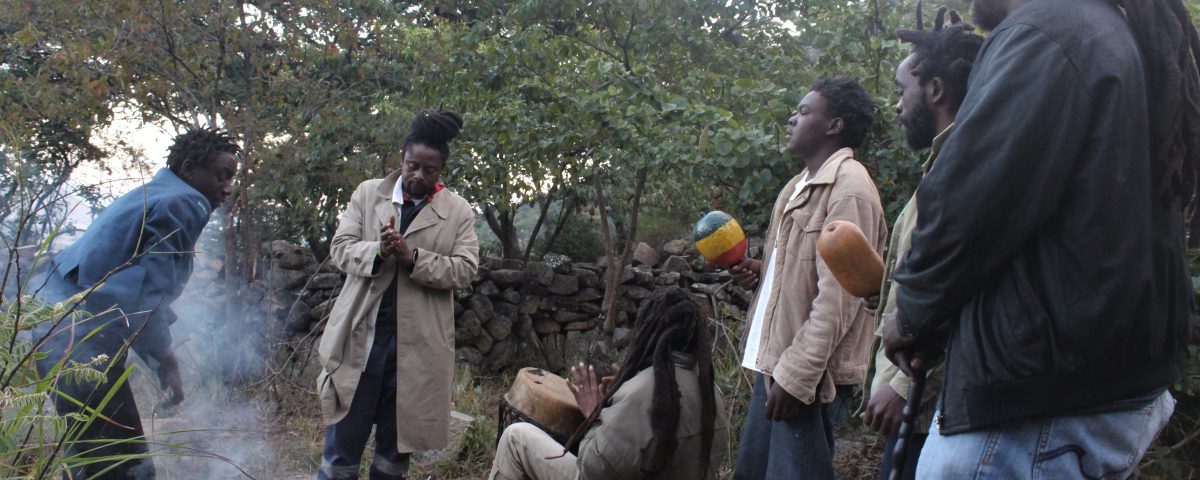
The Mutare Rastafarian community intends to build a Rastafarian village in Murahwa Hill. The Rastafarian culture can be a learning curve in the ongoing efforts to deal with the global climate change adaptation discourse.
…Rastafarians seek to pursue natural ‘livity’, that is, an independent life style that is in harmony with the natural world. This Rastafari ‘livity’ is acted out in various ways but the objective is to lead a way of life characterised by a sense of natural, organic purity, as well as cultural authenticity. Livity is a word used by Rastafarians to refer to the energy or life force that flows through all living things.
Ngoni Dapira
WHEN we hear about Rastafarians, the first thought is people with dreadlocks known to live a carefree life often associated with ‘peculiar’ smoking of marijuana. There is however more to the Rastafarian culture. It is actually a way of life that has over the years received little acknowledgement but in our modern day of the climate change catastrophe, the Rastafarian way of life deserves to be mainstreamed as environmental experts continue to explore ways of promoting sustainable use of the environment.
Climate change is a critical challenge that the world is facing today. The impact of climate change has resulted in a global climactic disasters on the environment and humanity. Initiatives by the South African based multi faith non-profit making organisation, Southern African Faith Communities Environment Institute (Safcei), in partnership with Act Alliance, which have been running the Faith Leaders Environmental Advocacy training (FLEAT) programme in Zimbabwe and a few selected countries in Southern Africa have provide FBOs with learning resources to conduct local eco-projects. This new paradigm of incorporating religion in the environmental discourse will be focal for the Rastafari faith that meticulously believes in the preservation and reclamation of the environment.
Through advocacy training, FLEAT has been building a network of change agents of faith across Southern Africa who are positioned to effect positive changes in their communities. It has worked with faith leaders from different faith groups that include Muslim, Christian (Lutheran, Presbyterian, Methodist, Anglican and Catholic), and Quaker. The represented countries are Zimbabwe, Zambia, Tanzania, Kenya, Malawi, Angola, Namibia, South Africa, Swaziland, Uganda and Mozambique. However, the Rastafarian creed has been overlooked but Eastern TimesZim decided to look into this small religious group dotted countrywide with presence in almost every city.
Rastafari ecological ethics play a complementary role to the national and global action in the preservation of the environment through their religious green practices. Shame Mudzengerere of the Mutare Rastafarai community said their faith is centred on reclamation and preservation of the environment. He said humanity has for centuries been polluting the land, air and water through deforestation, use of excessive fertilisers, pesticides, chemicals and industrial waste spillage, release of active chemical wastes, among others, but that has to be put to an end, of which as Rastafarians he believes they can teach people how to live in harmony with the environment and live in a sustainable way of life through their livity concept.
Rastafarians seek to pursue natural ‘livity’, that is, an independent life style that is in harmony with the natural world. This Rastafari ‘livity’ is acted out in various ways but the objective is to lead a way of life characterised by a sense of natural, organic purity, as well as cultural authenticity. Livity is a word used by Rastafarians to refer to the energy or life force that flows through all living things.
During the phase one Zimbabwe FLEAT programme held in July last year religion was highlighted as one of the key component to resolve the global environmental crisis, given that 90 percent of people in the world are part of a religious group. “Our way of life is directly opposed to the artificial lifestyles espoused through western consumerism. This is expressed through our vegetarian diet, hairstyle, and sense of community with emphasis on simplicity,” said Mudzengerere.
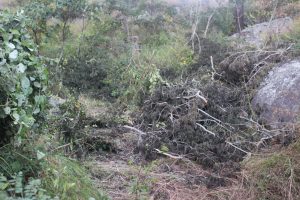
Remnanats of deforestation in Murahwa Hill that the Mutare Rastafarians are combating. Their shrine is up Murahwa Hill near the hig density suburb of Chikanga. Locals go up to cut tree in the hill.
Environmental experts regard trees as the ‘carbon sinks of the world’ since they can store carbon dioxide in their branches, trunks and leaves. With this function, trees reduce the growth of greenhouse gases and counteract global warming. It is also known that there has been rapid increase in the warming of the earth’s surface in the past 50 years. There is also evidence that this warming was largely due to anthropogenic factors such as deforestation, burning fossil fuels and changes in land use.
Although the Environmental Management Agency has over the years identified deforestation, drought and desertification, soil erosion, veld fires, water pollution, loss of biodiversity, water hyacinth invasion on lakes and dams, air pollution, poor waste management as well as land degradation as some of the major environmental challenges facing Zimbabwe, lack of forceful political by-in as well as clear and decisive government leadership have effectively rendered the agency ineffective.
For Rastafarians, living naturally implies producing one’s own food or eating a diet consisting of organic and vegetarian foods as well as upholding the sacredness of the earth by refusing to pollute and commercialise it. In their diet, Rastas advocate taking holistic and unprocessed foods such that some fruits and vegetables are eaten raw in order to attain maximum nourishment. In this manner, Rastafarians are consistent with the ways of Jah (God) and the pre-colonial African way of life that supports the pre-Babylon epoch says Mudzengerere.
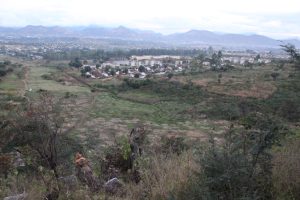
Part of the open land destroyed after deforestation where the Mutare Rastafarians want to do reclamation and practice perma-culture and start a citrus fruits orchard.
The Rastafarians say they require good land to practice their organic farming that does not pollute the land, crops and people through the over use of chemicals and fertilizers. They are suspicious of the fruits and vegetables they buy from the supermarkets as they may not be organic products. Some prefer to eat ganja as vegetables or drink it as tea but in general, it is smoked communally through the chalice as a ritual action. Attaining such a piece of land has been difficult but they have been improvising and knocking on many doors to fulfill their vision of establishing a Rastafarian village.
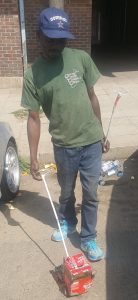
Toy cars made from used soft drinks and beer cans. by the Rastafarians.
The Mutare Rastafarians have also been practicing reusing and recycling from metal scrap material to reduce pollution of the environment. Some of the artefacts being made are toy cars from used cans of soft drinks and beers. Some make ends meet from making carved wood artefacts, reed mats and reed baskets which they sell. They however make it a point to replant every tree they cut in the spirit of replenishment and posterity of nature that would have put food on their tables. This way of life by Rastafarians is in-line with the global campaigns being encouraged of the three Rs: to Reduce, Reuse and Recycle. The utilisation of recycled resources to produce works of art and earn a living is a creative and innovative paradigm of thinking and acting.
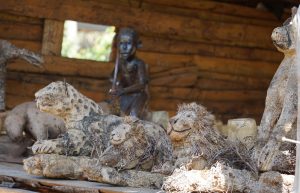
Some of the artefacts made from tree barks by Rastafarians.
In Mutare their place of worship (shrine) is on top of Murahwa Hill in the high density suburb of Chikanga. It is also located at this same site that the Rastafarian community intend to live as a community (the Rastafarian village). They are in negotiations with the Mutare city councillors to be given that land. “We first approached the then Mayor Tatenda Nhamarare in 2016 about the piece of land where our shrine is. Last year we pursued on the matter again and he advised us to write a letter to the new Town Clerk for the land,” said Mudzengerere. To them getting that piece of land will enable them to preserve nature and their culture. “We just want to restore the area and live there in our own village. When we get visitors they can come live there and experience our culture. We will also plant fruit trees so we can have fruit for ourselves and sell the excess in town. The place is very habitable, electricity lines run through the piece of land and water tanks that supply the city of Mutare is nearby, so we can actually support religious tourism that Government has been driving for and have our own Rastafarian village near our shrine. This will also allow people to learn more about our culture and beliefs,” said Mudzengerere.
Culture
For Rastafarians they believe in Emperor Haile Selassie Tafari Makonnen, better known as Ras (Prince) Tafari who was born on 23 July 1892. To them he is God (or Jah) incarnate, the second Messiah. He was Ethiopia’s 225th and last emperor who took the royal name Haile Selassie (the First), when he was crowned. Rastafarians believe Ras Tafari’s coronation in 1930 was the fulfilment of a prophecy and that he was their Redeemer, the Messiah who was written of, in the Bible’s Book of Revelation. Rastafarians also hold that Haile Selassie is a direct descendant of King Solomon and the Queen of Sheba, through their son Menelik I. Their signature dreadlocks were inspired by the Nazarites of the Bible so true Rastafarians believe that their dreadlocks are spiritual.
This explains where the roots of Rastafarians emanated from in Africa but eventually spread world over due to the slave trade. Mudzengerere said in the 19th Century pre-colonial history of Zimbabwe, revered spirit mediums like Sekuru Kaguvi and Mbuya Nehanda were dreadlocked, a belief that Zimbabwean Rastafarians strongly hold saying that originally all Africans lived a Rastafarian way of life but changed their way of life because of colonialism.
There was also the prophecy by Jamaican activist, Marcus Garvey, “Look to Africa when a black king shall be crowned, for the day of deliverance is near.” Garvey campaigned for political and social change on an island that had been an important centre for slavery. After the slave trade was abolished in 1833 and Abraham Lincoln’s Emancipation Proclamation freed all slaves, life did not improve. Following, Haile Selassie’s coronation in 1930, many of Garvey’s followers believed the day of deliverance was imminent and there was going to be an exodus to Africa, back to their roots. This however, did not happen as most slaves on the Caribbean Islands that had been shipped from West Africa, remained there whilst some travelled to other continents all over the world. Those that however stayed true to the Rastafarian way of life passed it on from generation to generation, which explains why the Rastafarians are dotted world-over and the culture survives up-to-date.
Rastafarians believe that African hair should not be shaved but kept into dreadlocks. In the Rastafari movement locks are symbolic of the Lion of Judah, which is sometimes centred on the Ethiopian flag. Even in the 21st century, some true Rastafarians are still trying to maintain a way of life that is natural and pure, which means being vegetarians. Ras Lazarus Tsiga leader (High Priest) of the Mutare Rastafarian community however said Rastafarian modern-day is now about one’s heart, not dreadlocks, but true Rastafarians are vegetarians and respect the environment. The Mutare Rastafarian community is part of the Marcus Garvey Rastafari House of Nyahbinghi Order in Zimbabwe. “We believe in self respect, self consciousness, self confidence and self reliance as Rastas. We also desist from violence and believe in humbling ourselves and living in peace and harmony with our environment,” said Tsiga.
Mudzengerere concurred that true Rastafarians are vegetarians. “We live off what grows from the soil. We grow our own fruit and vegetables and we do not eat meat or smoke tobacco (cigarettes). We eat according to Genesis 1 verse 29 in the bible. We take herbs for nourishment and medical treatment. We jealously guard trees and feel the pain when we see trees being cut or our environment being depleted,” said Mudzengerere. “Even when one of our own gets sick we first try herbs for curing before resorting to medical doctors. We are however not extremists like Apostolic sects that refute western medicine. We take it only when and if necessary,” added Mudzengerere.
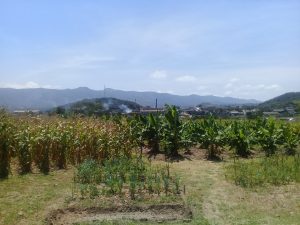
Land reclaimed where organic farming is taking place.
Contrary to misconceptions, Mudzengerere said true Rastafarians only smoke marijuana for meditation so as to get into a spiritual level. He said the herb unites them, like when they are travelling or have a task to do. He said marijuana is always smoked for ritual purposes. “Before smoking weed (marijuana) we say a prayer to Jah (God) or to Haile Selassie I. We call them reasoning sessions, and use the weed for Nyabinghi. A Nyabinghi session is different from a casual marijuana smoking session that others who are not Rasta usually take. We also do not approve of excessive alcohol consumption. However, we can drink alcohol in moderation as long as it does not reach a level that clouds the mind or reduces their livity.”
Mudzengerere added that for the children below 18 years smoking marijuana is prohibited. He said even though it is part of their culture they only allow children to start smoking marijuana when they reach the legal age of adulthood which is 18 years, an age when they can make their own decisions maturely.
BELIEFS
Rastafarians believe the second coming of Christ came in the mould of Emperor Haile Selasie of Ethiopia. They say on 2 November 1930 he was ordained in the presence of 72 Kings and was given all titles that Christ was given as written in the Bible in Isaiah 9 verse 6. “When we say Jah it is the same as saying Jehova,” said Ras Samuel Makaza another Rastafarian from Mutare quoting Psalms 68 verse 4.
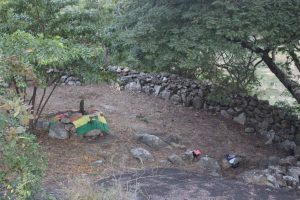
The Mutare Rastafarian shrine up Murahwa Hill.
Rastafarian church services are held on Saturdays and they fast on the day. Before entering their shrine they remove their shoes. The service starts with lighting of a key fire, of which not less than three people can light the fire. Seven seals are opened during the lighting ceremony and read verses from Psalms 68,2,83,94,20 and 9 in that order during the ceremony. The fire is believed to protect them and chase away evil spirits. They believe the fire also burns all sins thereby purifying them. After lighting of the fire songs are sang to praise Jah and thereafter Psalms 121,122,133 and 24 are read in that order and more praise and worship is done to invite Jah to come down among them.
They have a session afterwards that they call ‘iron sharpens iron’, where ideas are shared among the congregants. It can be from business ideas or anything that can help develop each other. That is also the time they break their fasting and share fruits they would have brought. They believe this spirit of sharing increases their ‘one love’ conception among them. I their final session they beat their drums and sing in praise and worship before departing.
RASTAFARIAN CALANDER EVENTS
Every year Rastafarians celebrate Black History month in February, the Bob Marley commemorations in May, Africa Day on May 25, the birth of Emperor Haile Sellasie on July 23, the coronation day of Emperor Haile Sellasie on November 2, Kwanza Day (first fruits celebration) in December and Nativity Day, which is the day they believe Jesus was born, their own version of Christmas. Instead of celebrating Christmas on December 25, Rastafarians believe 25 December is actually the day when King Herod killed all male children in an attempt to kill Christ and avoid the prophesy.


